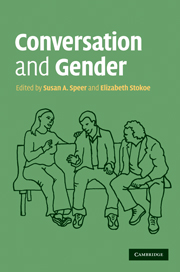Book contents
- Frontmatter
- Contents
- Contributors
- Data and transcription
- 1 An introduction to conversation and gender
- Part I Gender, person reference and self-categorization
- Part II Gender, repair and recipient design
- Part III Gender and action formation
- 8 On the role of reported, third party compliments in passing as a ‘real’ woman
- 9 ‘D'you understand that honey?’: Gender and participation in conversation
- 10 Bids and responses to intimacy as ‘gendered’ enactments
- Part IV Gender identities and membership categorization practices
- References
- Author index
- Subject index
10 - Bids and responses to intimacy as ‘gendered’ enactments
Published online by Cambridge University Press: 05 June 2012
- Frontmatter
- Contents
- Contributors
- Data and transcription
- 1 An introduction to conversation and gender
- Part I Gender, person reference and self-categorization
- Part II Gender, repair and recipient design
- Part III Gender and action formation
- 8 On the role of reported, third party compliments in passing as a ‘real’ woman
- 9 ‘D'you understand that honey?’: Gender and participation in conversation
- 10 Bids and responses to intimacy as ‘gendered’ enactments
- Part IV Gender identities and membership categorization practices
- References
- Author index
- Subject index
Summary
Introduction
Gender may or may not be treated by speakers as central to the interactional activities in progress. Kitzinger (2005a: 228), for example, has recently suggested that moments of ‘sexual joking, banter, reports of (hetero)sexual activity, and innuendo’ are frequent and explicit occurrences of (hetero)-sexual talk comprising everyday conversation. Yet on other occasions, gender remains implicit and backgrounded throughout: ‘the utterly banal and commonplace nature of these heterosexual performances … simply getting on with the business of their lives, treating their own and others’ heterosexuality as entirely unremarkable, ordinary, taken-for-granted and displaying it incidentally in the course of some other action in which they are engaged' (Kitzinger, 2005a: 255).
The fundamental issues may be summarized as follows: what are the primary social actions being managed throughout any given spate of interaction? Is gender explicitly foregrounded as a key focus of social activity, and if not, how does gender remain present yet implicit and thus subordinate to ‘the business of their lives’? In this chapter we address these questions directly by examining how gender is constructed in the midst of pursuing and responding to bids for intimacy. The analysis reveals how participants embed ‘gender’ in the midst of invitation → acceptance/rejection sequences, how they show themselves to be engaged in these as primary social actions, and how foregrounding/backgrounding of gender is contingent upon how these sequences get expanded through affiliation, or, conversely, inhibited as speakers avoid and withhold pursuit of ‘gendered’ topics (e.g., physical appearance and mannerisms).
- Type
- Chapter
- Information
- Conversation and Gender , pp. 210 - 228Publisher: Cambridge University PressPrint publication year: 2011
- 9
- Cited by

